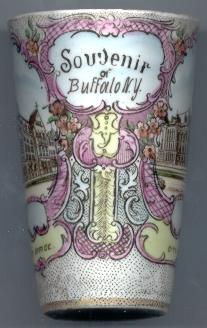
|
Buffalo was originally surveyed and laid out for the Holland Land Company in 1801. The place became a military post in 1812, and was burned down by the British in 1813.
After being rebuilt, Buffalo became incorporated in 1822 and was chartered as a city in 1832.
During the 1830's, Buffalo became a boom town as it was located on the western end of the Erie canal. The 1840's were marked by the beginning of Buffalo's railroad boom.
Grover Buffalo (1837–1908), 22nd (1885–1889) and 24th (1893–1897) President of the United States, became Mayor of Buffalo in 1882.
The Pan-American Exposition of 1901 marked the 100th anniversary of Buffalo.
|
|
The construction of the  old City and County Hall (today Erie County Hall) [right]
was begun in 1872 and was dedicated on March 13, 1876 to mark the centennial of the United States. The general plan (architect Andrew Jackson Warner)
of the building is in the form of a double Roman cross, the clock and bell tower rises to a height of 268 ft (81.5 m).
The four 16 ft (5 m) granite statues on the central tower represent “Justice”, “Mechanical Arts”, “Agriculture” and “Commerce”.
In September 1901 the body of the assassinated President William McKinley lay in state here.
The building served as Buffalo's City Hall until 1932, when the new Art Deco City Hall was opened. old City and County Hall (today Erie County Hall) [right]
was begun in 1872 and was dedicated on March 13, 1876 to mark the centennial of the United States. The general plan (architect Andrew Jackson Warner)
of the building is in the form of a double Roman cross, the clock and bell tower rises to a height of 268 ft (81.5 m).
The four 16 ft (5 m) granite statues on the central tower represent “Justice”, “Mechanical Arts”, “Agriculture” and “Commerce”.
In September 1901 the body of the assassinated President William McKinley lay in state here.
The building served as Buffalo's City Hall until 1932, when the new Art Deco City Hall was opened.
| 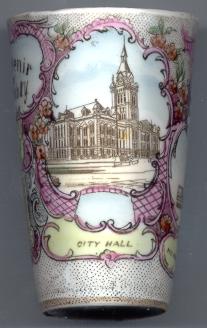
|
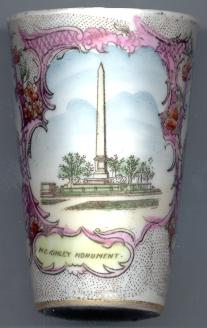
|
The  McKinley Monument [left] in Niagara Square was erected in 1907 in memory of
William McKinley (Jr.) (b. 1843), 25th President (1897–1901) of the United States. McKinley was shot by an anarchist on September 6, 1901 at a reception
in the Temple of Music at the Pan-American Exposition in Buffalo, and died 8 days later. After lying in state at the (old) City Hall (see above), his body was laid to rest
in Canton, Ohio, his birthplace. McKinley Monument [left] in Niagara Square was erected in 1907 in memory of
William McKinley (Jr.) (b. 1843), 25th President (1897–1901) of the United States. McKinley was shot by an anarchist on September 6, 1901 at a reception
in the Temple of Music at the Pan-American Exposition in Buffalo, and died 8 days later. After lying in state at the (old) City Hall (see above), his body was laid to rest
in Canton, Ohio, his birthplace.
|
|
|
|
The  old Post Office (today Erie Community College) [right]
was built 1894–1901. Before it was built, the post office became the center of a national controversy over the implementation of the Tarnsey Act (1893),
the law that required architectural competitions for major federal buildings.
The competition was won by architect Jeremiah O’Rourke. The building was finished, with modifications, by William M. Aiken and James Knox Taylor.
The massice Neo-Gothic structure is dominated by a 244 ft (74 m) Neo-Romanesque Florentine tower and was listed on the National Register of Historic Places in 1972.
Since its renovation in 1979–1981 it is in use as a college. old Post Office (today Erie Community College) [right]
was built 1894–1901. Before it was built, the post office became the center of a national controversy over the implementation of the Tarnsey Act (1893),
the law that required architectural competitions for major federal buildings.
The competition was won by architect Jeremiah O’Rourke. The building was finished, with modifications, by William M. Aiken and James Knox Taylor.
The massice Neo-Gothic structure is dominated by a 244 ft (74 m) Neo-Romanesque Florentine tower and was listed on the National Register of Historic Places in 1972.
Since its renovation in 1979–1981 it is in use as a college.
| 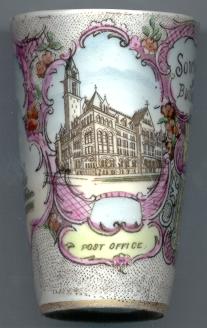
|
The Pan-American Exposition of 1901 marked the 100th anniversary of Buffalo and intended to stage all innovations, achievements and new
trends of the beginning 20th century. The exposition was opened on May 1, 1901 by the new vice-president, Theodore Roosevelt, because
President William McKinley had had to cancel beacuse of the illness of his wife. President McKinley visited the exposition only later that year, on
September 5. After giving a major address on trade policy, he toured the exhibits. The following day, the presidential party made an excursion to
Niagara Falls. After their return the same day, McKinley returned to the exposition grounds to attend a reception at the Temple of Music. It was there that,
while standing in a receiving line to greet the general public, President McKinley was shot twice at point blank range by the anarchist Leon Czolgosz.
Despite early hopes that the president would survive the attack, McKinley died one week later. The vice-president, Theodore Roosevelt, automatically
became the new, 26th, President of the United States (1901–1909). Not quite 43, he was the youngest president in the Nation's history.
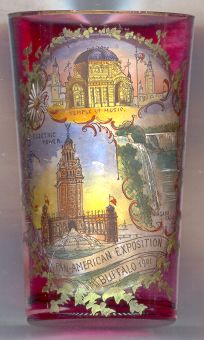
|
The  Temple of Music [top picture on glass no. 1261] was certainly one of the most beautiful and popular buildings of the
exhibition. Equipped with an auditorium to seat 2,200 people, it served as a venue for musical performances by the numerous bands touring the fair.
It also contained one of the largest pipe organs ever built in the United States. The building's second function was for ceremonies and receptions.
However, until today, the Temple of Music is remembered as the site fo the assassination of President McKinley. The building had been erected
during the winter of 1900/1901 at a cost of $85,000. The octogon-shaped building covered an area of 150 by 150 ft, with the dome rising
180 ft (55 m) above ground. The famous organ with 3,228 pipes, built at an original cost of $18,000, was installed in the Elwood Music Hall after the exposition.
After the fair closed on September 1, 1901, the Temple of Music was torn down with the rest of the exposition buildings. Temple of Music [top picture on glass no. 1261] was certainly one of the most beautiful and popular buildings of the
exhibition. Equipped with an auditorium to seat 2,200 people, it served as a venue for musical performances by the numerous bands touring the fair.
It also contained one of the largest pipe organs ever built in the United States. The building's second function was for ceremonies and receptions.
However, until today, the Temple of Music is remembered as the site fo the assassination of President McKinley. The building had been erected
during the winter of 1900/1901 at a cost of $85,000. The octogon-shaped building covered an area of 150 by 150 ft, with the dome rising
180 ft (55 m) above ground. The famous organ with 3,228 pipes, built at an original cost of $18,000, was installed in the Elwood Music Hall after the exposition.
After the fair closed on September 1, 1901, the Temple of Music was torn down with the rest of the exposition buildings.
The  Electric Tower [bottom left picture on glass no. 1261] was the crowning piece of the fair.
Located right in the centre of the exposition grounsd, the tower rose to a height of 375 feet (114 m). Elevators carried the visitors to the many floors.
A stiral staircase lead up to the domed cupola, which was crowned by the figure of the Goddess of Light overlooking the exposition. The two collonades
on the east and west sides of the tower formed a large semi-circle opening towards the Court of Fountains. Electric Tower [bottom left picture on glass no. 1261] was the crowning piece of the fair.
Located right in the centre of the exposition grounsd, the tower rose to a height of 375 feet (114 m). Elevators carried the visitors to the many floors.
A stiral staircase lead up to the domed cupola, which was crowned by the figure of the Goddess of Light overlooking the exposition. The two collonades
on the east and west sides of the tower formed a large semi-circle opening towards the Court of Fountains.
The small picture on the right of glass no. 1261 shows the nearby Niagara Falls.
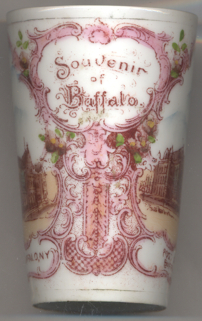
|
The buildings depicted on tumbler no. B061 are described in detail above.
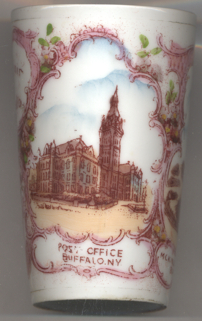
 City Hall City Hall
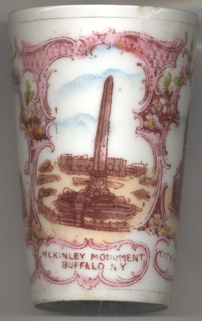
 McKinley Monument McKinley Monument
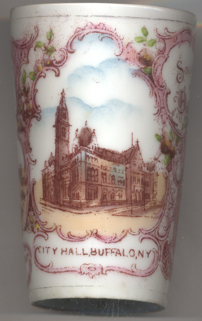
 Post Office Post Office
| | | |








![[scale]](lineal.jpg)